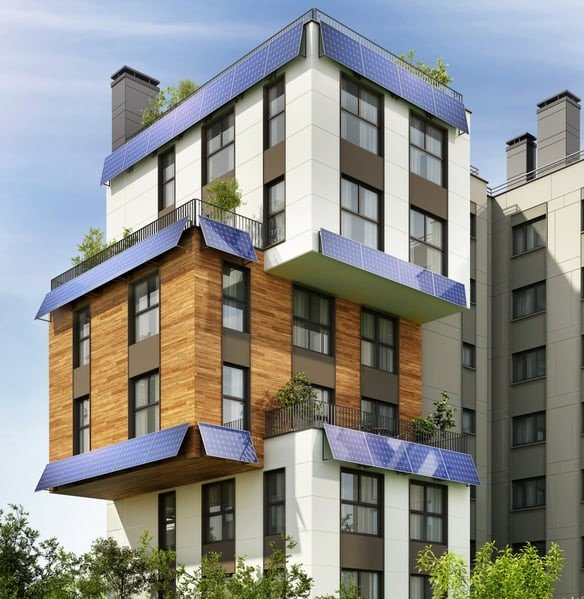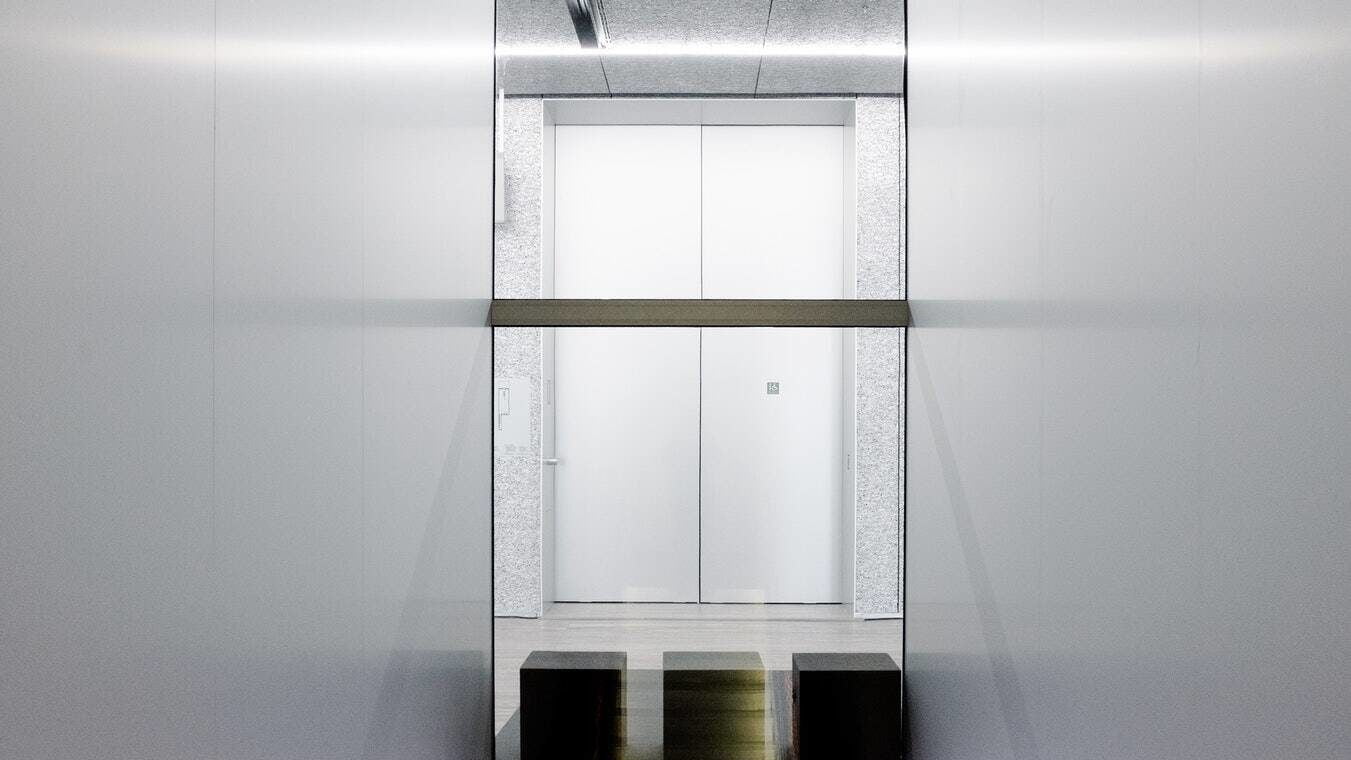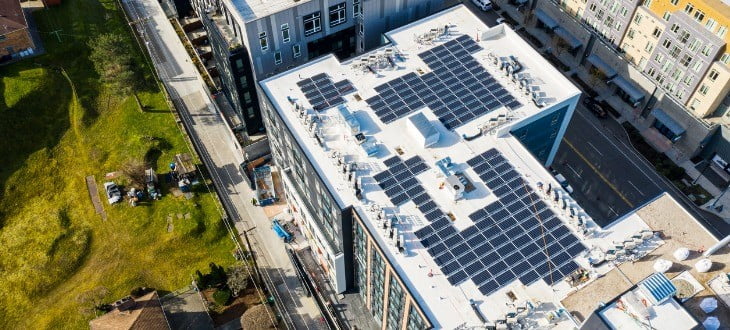
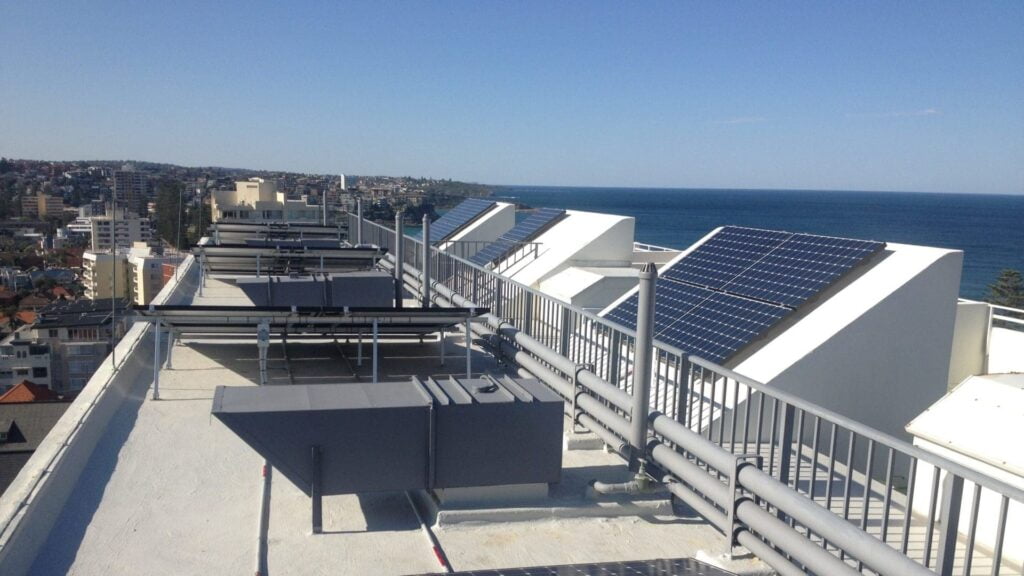
Going solar has increasingly become popular in the world. It is not only a matter of people being more conscious about the environment but also because solar PV technologies have become more efficient and affordable over time.
Many would say that solar energy is a viable option only for detached houses and people who own their roofs. And, yes, getting photovoltaic panels for an apartment implies extra difficulties, but there certainly are some ways you can power your flat with solar energy.
Are you curious about getting solar panels for your apartment? If so, we can help you. Our team at ExpoTech will make your apartment buildings truly solar.
Can You Put Solar Panels on Apartment Blocks?
The short answer is: yes.
You can put solar panels on apartment buildings in the UK; however, it is not as straightforward as for detached houses.
If you are a tenant, you will need to ask your landlord to install solar panels on flat roofs, balconies, or other suitable spots. This is a major property upgrade for landlords, so you will need to make a case and convince them.
You could, for instance, focus on the increase in property value, energy bill reduction or attracting (future) tenants already interested in solar energy.
Furthermore, even if both you and your landlord are willing to install solar panels for the apartment, you will need permission from relevant institutions. Since landlords own only the flat and not the entire apartment block, they need approval from bodies such as neighbour councils or building management boards.
Moreover, you must comply with all rules related to altering the style or structure of buildings in the area you live in.
In any case, using solar panels to meet at least part of your flat’s energy needs can make a difference for the environment. Let’s bring some data in and put it into context:
According to Ofgem, the average household in the UK (2-3 people) uses approximately 2,900 kWh of electricity and 12,000 kWh of gas each year. On the other hand, the UK government points out that carbon emissions for homes on the average energy fuel mix are currently 0.193 kg of CO2e per kWh of electricity and 0.183 kg of CO2e per kWh of gas. We do not have any data for Bangladesh at the present moment.
Let’s say that you cover just 10% of your flat’s electricity and gas consumption with solar panels; then, you would save around 275 kg of CO2e per year. That is the amount of CO2 that 13 fully grown trees would take 1 year to absorb. In other words, you can make a difference by going solar!
If you’ve decided to go for a solar panel system for an apartment building, you will need to spend several hours researching technical specifications and local regulations. You will also need to contact several installers in your area to compare their offers and get competitive prices.
Fortunately, we can help you reduce that time to just 5 minutes or even less. Click on the button below, fill in the form, and our experts will send you up to 3 quotes tailored to your needs. We work with a nationwide network of certified professionals, so we’ve got you covered. Our service is free, and you are not obliged to accept any quote you receive.
Where Can You Place Solar Panels on Apartment Buildings?
In theory, you can place solar panels on apartment buildings in any suitable, allowed spot. These could be the roof, balcony floor, balcony railings, window sills, and bannisters.
If using the building’s roof is an option, you can opt for traditional bolt-on solar panels. You can check our article What Is the Cost of Solar Panels in the UK? for detailed information on prices and how much you can save on energy bills.
In case the roof is not available for you to use, then you could mount plug-in or portable solar panels anywhere in your apartment that gets enough sunlight. It could be, for instance, on a balcony or a railing.
Is it possible to get solar panels for your apartment balcony?
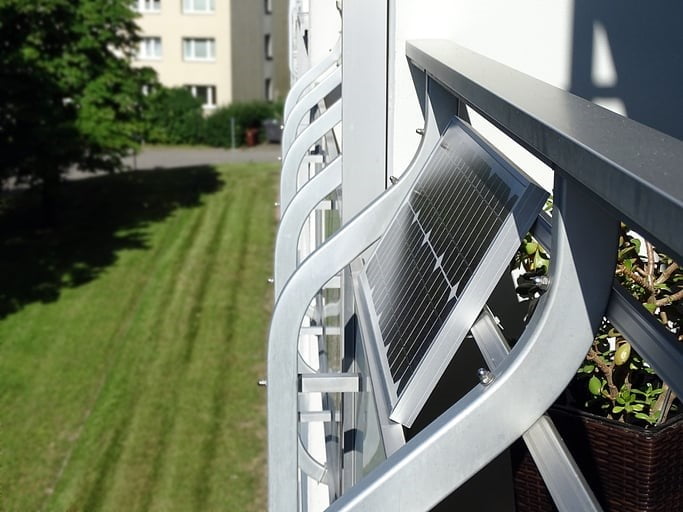 Getting solar panels for an apartment balcony is totally possible. Probably the best option is buying a plug-in or plug-and-play solar panels. They work pretty much as their name suggests: you just need to mount them on a spot that gets a lot of sunlight, plug them into any standard wall outlet, and the energy they produce will flow into your apartment.
Getting solar panels for an apartment balcony is totally possible. Probably the best option is buying a plug-in or plug-and-play solar panels. They work pretty much as their name suggests: you just need to mount them on a spot that gets a lot of sunlight, plug them into any standard wall outlet, and the energy they produce will flow into your apartment.
These kits normally need some outdoor space where you can safely secure panels. It could be a sunny balcony but also a patio, yard or rooftop. Some of them are more complex, and you will need a certified installer to fit and set them up.
Also, be aware that they might not account for your home’s whole energy demand. However, even if you cover just a fraction of your apartment’s energy needs with solar energy, you would be already reducing the total amount of CO2 released into the atmosphere and, therefore, helping the environment.
In any case, plug-in solar panels are a suitable solution for renters as they can take the panels with them if they move to a different place. Of course, you will have to research what size the solar panel kit should be to meet your requirements and check if your city has any regulations in place on the use of these types of panels.
Additionally, as they will take some space, ask yourself if your balcony is large enough to accommodate them and if you want to use the balcony for other purposes. Also, consider if they will affect your neighbours somehow (e.g. ruin their view).
Smaller portable solar panel systems can also be of some help. Typically, portable solar panels can produce between 0.3 and 1.5 kWh per day. They are mostly used for outdoor activities or for recreational vehicles such as campervans, but they can also help you charge your phone or laptop and even run small electric appliances in your apartment.
As they normally are very lightweight, you can set them up on window sills, railings, and banisters or anywhere with sun exposure. Many of them also include battery storage, so you can use the generated solar energy at any time of the day.
Solar panels for apartment windows
Solar window technologies are still in development. At the moment, they lack adequate efficiency for converting sunlight into energy. However, it is improving, making energy-generating windows a promising space-saving alternative to portable solar panels for apartments.
There are also mini solar chargers you can hang on the window’s pane as decor, such as the bamboo-framed mini panel by Grouphug. These small solar chargers can only produce enough energy for a Smartphone or similar electronic devices.
Other solar alternatives for apartments
Besides the abovementioned options, there are other solar alternatives for apartments you can consider even if your flat does not get sufficient sunlight. In this regard, joining a community solar project is a great option for people who can’t put solar panels on their roofs.
Community solar projects are medium-to-large-scale solar farms built locally —and sometimes collectively owned— that power multiple homes in a community. However, they are not that extended across the UK, and you may not find any in your area.
Another alternative is building your own portable solar panel system. For this, you need to buy all the necessary components and equipment and connect everything yourself. You also need to have all the required knowledge on electric systems to build it and make it work.
Pros and Cons of Solar Panels for Apartments
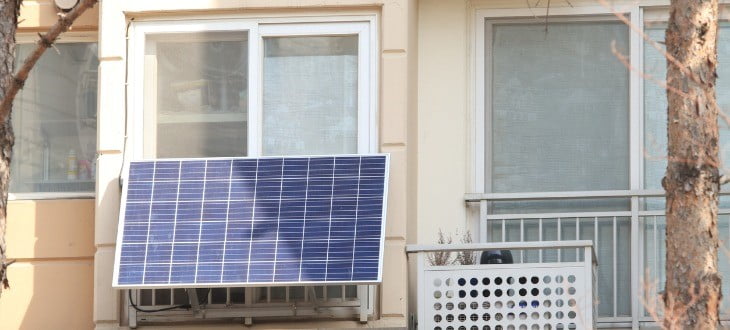
Pros of solar panels for apartments
-
1. Reduce your energy bills. Since you are generating (part of) the electricity you consume using free solar energy, your electricity bill will be lower. The more independent from the national grid you become, the lower your monthly bill.
-
2. Reduce your carbon footprint. Similarly, the less fossil-fuel-generated electricity you consume, the lower your CO2 emissions.
-
3. Increase your property value and attract new tenants. If you own your apartment, powering it with renewable energy will increase its value. This could benefit you if you ever decide to sell. It can also attract renters who are looking for environmentally friendly options.
-
4. Reduce reliance on the electrical grid. Using battery storage systems and solar panels for your apartment will reduce your dependence on the grid. If the grid is down for any reason (e.g. power outage during planned disruptions, maintenance or emergencies), you would still be covered, at least for using the essential appliances.
Solar panels for apartment buildings have many advantages in general.
Cons of solar panels for apartments
-
1. Solar panel installation can be expensive. To give you an idea, a standard 250W solar panel in 2022 costs £400-£500; however, it is not enough to power an entire home. A 3kW solar panel system —which is ideal for homes of 2-3 people— usually costs around £5,000 – £6,000 and will cover around 22 square metres.
-
2. Portable and plug-in solar panels are not powerful enough. Even if they can help you cover part of your home’s energy needs, you’ll need to continue using grid power to meet the majority of it.
However, there are also relevant disadvantages you must consider.
Disadvantages and limitations notwithstanding, using solar panels to meet at least part of your flat’s energy needs can make a difference for the environment.
If you’re ready to switch to solar and enjoy all of its advantages, we can help you.
As mentioned, solar panels can be expensive; however, comparing quotes can help you save on the upfront costs. Finding quotes can be a tedious and time-consuming task, but our team at ExpoTech can help make it easy for you.
There are 4 options to install solar power on strata buildings
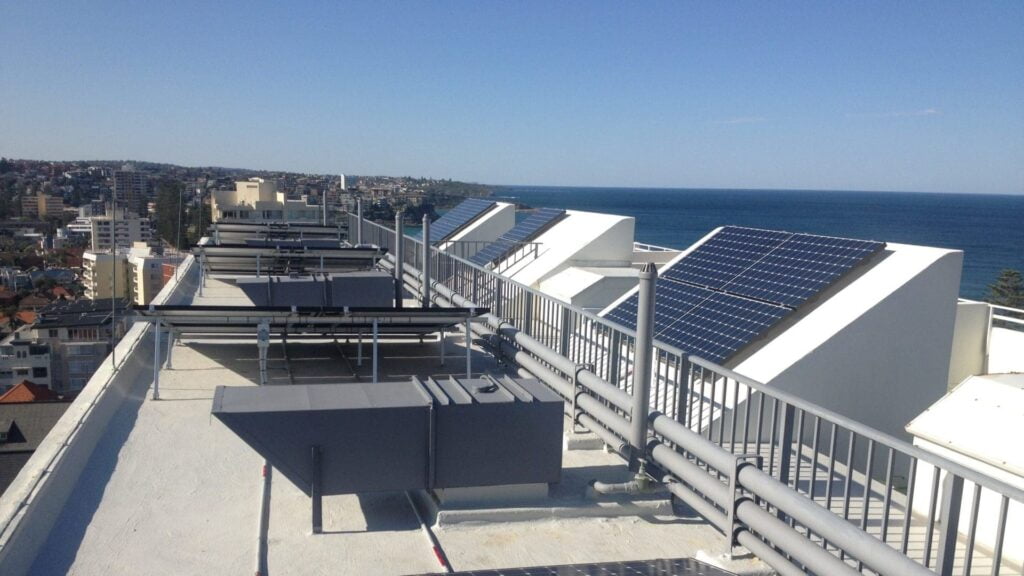
Option 1: Solar for the common areas
Each strata building has a dedicated meter for the common areas, where lights, lifts and other communal equipment run; the electricity bill associated with this meter is paid for out of strata levies. For very tall apartment blocks with limited roof space this is the simplest option to install solar as it is a communal cost and everyone will (or should) benefit equally from it in the form of reduced strata bills. Furthermore, the capital expenditure required to purchase such a system can be relatively small, especially if the strata building does not have any communal lifts, air conditioning, pools or other devices which use a large amount of electricity.
Main advantages:
- Relative simplicity, with one solar PV system behind just the common area meter
- All owners benefit equally through reduced common costs (usually covered by strata levies) Extra power on the common area meter can be useful for Electric Vehicle Charging
When getting quotes for your strata committee it is important to find installers with experience installer on high-rises and concrete roof-spaces. Solar Choice has a network of installers, and we can help you find the local options with the right experience.
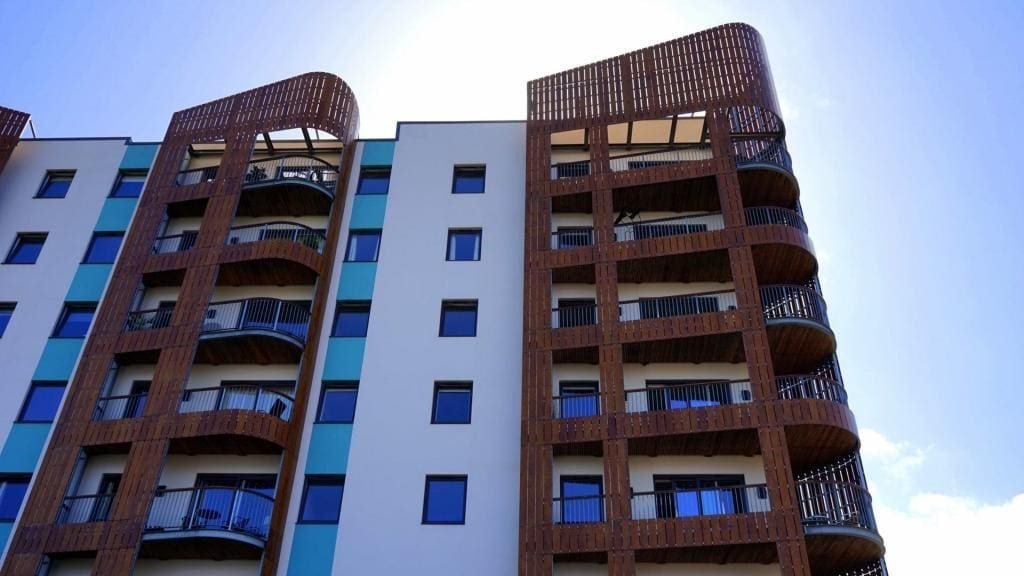
Options 2: Each unit gets a separately-metered solar system
If the common area bills are already quite small, or if the unit owners are more interested in solar to benefit themselves or their tenants directly, then it may make sense to have a solar system installed for each unit. At this point, however, there is the question of roof allocation. This is a consideration that doesn’t come to mind for most people when they purchase a unit, but one which is sure to arise if one individual owner asks to install a solar system for their unit (unless the units are townhouses).
In this case, in the name of ‘fair share’, it makes sense for the solar-friendly (i.e. unshaded and north/west/east-facing) sections of roof to be pre-emptively divided up between all the owners. This could turn out to be complicated, especially if the roof is multi-faceted and has shading issues in more than one place. If the strata building has a section of roof with full and equal solar access, this challenge should be relatively clear-cut and easy to solve.
If your strata committee gets to this point, you’ll then need to work out how much each section of roof area will translate into in terms of solar panel capacity. In the end, each system may be quite small (1.5kW–2kW), especially if the building is more than 2-3 stories tall and there’s significantly more floor area than there is roof area. In either case, the most financially sensible approach may be to have all the solar systems installed at the same time and by the same company, as smaller systems tend to be more expensive per watt of capacity than larger ones, and the way to bring down the overall cost would probably be a bulk buy.
Main advantages:
- Provided there is ample viable roof space to go around, each unit has its own solar system, wired up to their own individual meter. This means that there’s no question of whether the benefits of the solar are being shared around in an equitable way, as actual savings will come down to how individuals use energy throughout the day.
- Each unit may have the option to own their solar PV system separately
Main disadvantages:
- Question of how to fairly allocate available roof area between units
- As the individual systems will be small and wired up individually, they may be expensive on a per-watt basis compared to solar for stand-alone homes, affecting their financial attractiveness
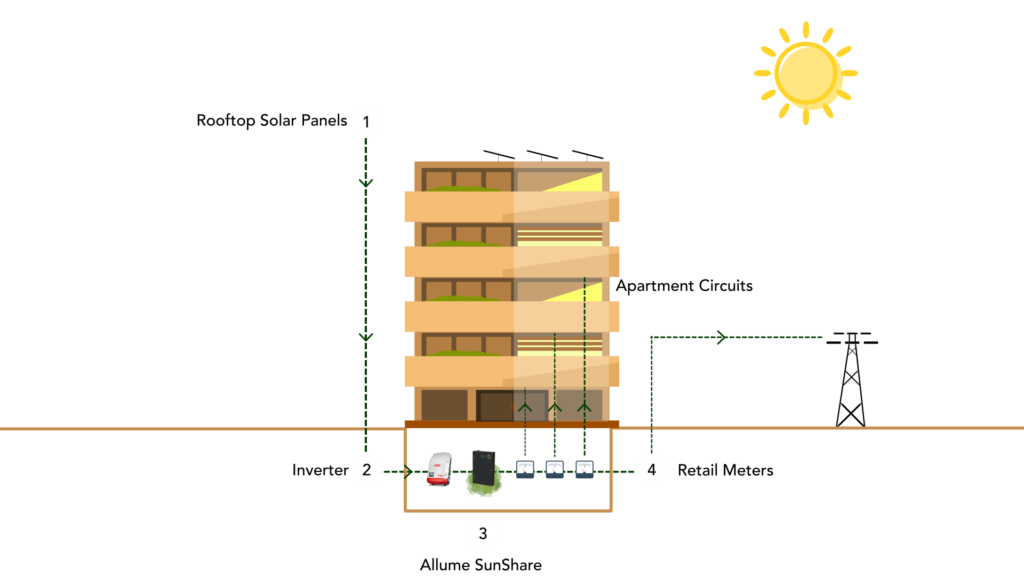
Option 3: A single solar system shared to individual apartments
This is a relatively new approach, and currently, there is only one company (that we are aware of) in Australia with the technology to deliver it. Allume Energy with its SolShare solution have solved a number of the issues outlined at the top of this article.
The SolShare solution is essentially a smart diverter that enables solar energy from a single rooftop solar system to be shared between multiple apartments within the same building. To make the system as efficient as possible but also fair, the SolShare delivers the same amount of solar energy to each apartment over the course of a month but supplies it when it’s needed by each unit.
In addition, the technology incorporates energy monitoring software, so that you know how much electricity you’re using throughout the day and when solar energy’s available.
Main advantages:
- Any metered unit can be connected, including common light and power.
- Units can opt out if they don’t want to be connected.
- The system is bought by the owner’s corporation, removing complications around individual roof space ownership.
- No changes to existing metering infrastructure is required – everyone retains their right to choose their electricity retailer.
- Participation is not mandatory; meaning only a 50% vote is required (75% in some states)
Main disadvantages:
- The Allume solution comes at an additional upfront cost to a traditional solar system, so typically it is better if there are 5 or more owners participating
- This is a new model that has only been deployed in a relatively small number of situations, with Allume Energy being the only company supplying this type of solution in Australia
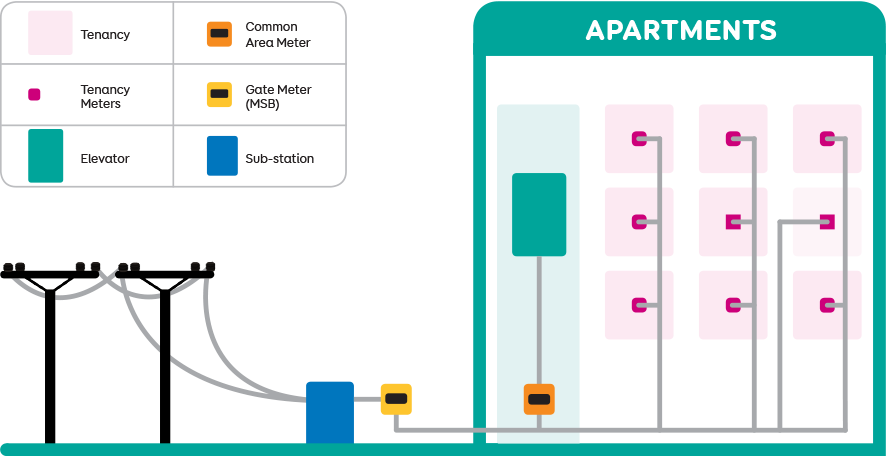
Option 4: Single system with embedded network
If your building is not set up on an embedded network already, then this approach is the most complex, difficult, and potentially costly of all the options listed here. An embedded network is basically a private ‘microgrid’ within a strata building. Every unit is metered separately behind a ‘master’ meter that connects the building to the grid. Individual units in an embedded network are generally promised cheaper rates for their electricity, regardless of whether there is solar or not.
In instances where solar is installed on an embedded network, the energy produced can theoretically be ‘split up’ equitably among units and supplied at an even lower rate than under a PPA (or possibly at no cost). Even feed-in credits could be split up among different units. Legally, residents of individual units would still have their choice of electricity retailer (if they live somewhere with a competitive market).
While the embedded network solution is the most ‘thorough’ of those listed here, it is also the most fraught with complications and the most difficult to implement – especially for existing buildings where an embedded network would need to be retrofitted. The first hurdle is getting agreement would be the strata committee, where a unanimous vote would be required in order to take any action. Given the potentially large costs and a broad variety of approaches, there’s a considerable chance that the project would never get past initial committee discussions without some serious dedication on the part of its members.
Another important challenge is the requirement to get approval from the Embedded Network Manager (ENM). In the National Electricity Market (NEM), every embedded network needs to have a registered manager, due to Power of Choice regulations. The ENM is not incentivised to allow the Body Corporate to install solar as it means they are drawing less power through their gate meter and selling less power to the residents. Solar would also mean a change in the ENM’s billing system which would be difficult to negotiate.
Diagram of an embedded network. (Image via MyComm Energy.)
Main advantages:
- Potentially the most equitable way to supply solar energy to units in a strata building that also helps to deliver the full potential value of solar energy (i.e. ‘free’ solar energy to be consumed during the day, plus solar feed-in credits)
- Depending on the arrangement, a single electricity bill for each unit with appropriate charges & credits
Main disadvantages:
- Could be prohibitively costly to implement – especially if applied as a retrofit solution instead of as part of a new development
- A wide range of suppliers and specific approaches could make it difficult or time-consuming for strata committees to decide on the one that best suits their situation and needs, or to get a unanimous agreement about the best approach among committee members
- Additional red tape associated with Power of Choice regulations governing the establishment of embedded networks
- Possibly a number of questions to ask and answer about exactly how solar energy will be divvied up among residents
Benefits
Tailorable kWp to each flat
Maximise you ROI by directing the exact amount of kWp to each flat.
Zero resident engagement
No sign ups, no complexity.
Monitors all energy data
SolCentre provides you with all the energy data you need: total energy demand, and solar delivered, consumed & exported. On a per flat basis.
Pairs with complimentary tech
Pair SolShare with batteries, PV diverters, and smart devices to achieve your sustainability goals.
Seamless integration
Suitable for private & B2R, and traditional or private wire building networks.
Reduces the Dwelling Emission Rate (DER) & running costs
Improve the carbon savings (DER) and the running costs of the building.
See how gets the most from your solar PV system
FLAT TYPE |
COUNT |
KWH PER YEAR |
SAP RATING |
EPC BAND |
KWP |
SAP RATING |
EPC BAND |
SAP SCORE INCREASE |
|---|---|---|---|---|---|---|---|---|
|
2B4P Top floor |
1 |
1200 |
72 |
C |
1.5 |
81 |
B |
9 |
|
2B4P Mid floor |
2 |
825 |
77 |
C |
1 |
82 |
B |
5 |
|
2B4P Ground floor |
1 |
1205 |
72 |
C |
1.6 |
81 |
B |
9 |
|
1B2P Top floor |
4 |
775 |
76 |
C |
1 |
82 |
B |
6 |
|
1B2P Mid floor |
8 |
500 |
80 |
C |
0.5 |
82 |
B |
2 |
|
1B2P Ground floor |
4 |
800 |
75 |
C |
1 |
82 |
B |
7 |
|
|
|
14995 |
kWh/year total requirement* |
|
32.4 |
kWp overall array required |
